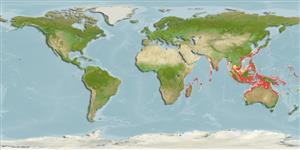分类 / Names
俗名 | 同种异名 | Catalog of Fishes(属, 种) | ITIS | CoL | WoRMS | Cloffa
Teleostei >
Pleuronectiformes (Flatfishes)
鰈目 (Flatfishes) >
Bothidae (Lefteye flounders)
Etymology: Crossorhombus: Greek krossoi = tassel + Greek, rhombos = paralelogram (Ref. 45335).
More on author: Alcock.
Environment: milieu / climate zone / depth range / distribution range
生态学
海洋 居于水底的; 深度上下限 13 - 60 m (Ref. 9824). 熱帶
Indo-West Pacific: Bay of Bengal, northwestern Australia, South China Sea, China, Taiwan, Japan, Viet Nam, and Aru Islands, Indonesia.
印度-西太平洋: 孟加拉灣,澳洲西北部,南中國海,中國,台灣,日本,越南與印尼的阿盧巴群島。
大小 / 重量 / 年龄
Maturity: Lm ? range ? - ? cm
Max length : 18.0 cm TL 雄鱼/尚未辨别雌雄; (Ref. 9824)
背的软条 (总数) : 84 - 92; 臀鳍软条: 63 - 74. Ground colour on eyed side brownish grey, with darker spots and blotches. Fins paler than body, dorsal and anal fins with small dark spots, caudal fin with 2 distinct dark bands. Males with small dark spots in anterior part of interorbital region. Blind side whitish in females. Males with distinct bluish black pyriform colour pattern on blind side. Body ovoid, its depth 1.7 to 2 times in SL. Head small, snout shorter than eye, profile steep anterior to interorbital area. Head length 3.3 to 4.5 times in SL. Interorbital region broad and concave, wider in males than females in specimens greater than about 6 cm SL. Males with a rostral spine and 1 to 3 low bony bumps around orbits. Both eyes on left side of head, front margin of upper eye slightly behind front margin of lower eye. Both eyes in males larger than about 6 cm SL with a flap on posterior area. Mouth small, reaching to or slightly beyond anterior margin of lower eye, length of upper jaw 3.1 to 4.3 times in head length. Teeth in upper jaw biserial, teeth of outer row more widely spaced than teeth of inner row; teeth in lower jaw uniserial. Gill rakers short and pointed. Scales on eyed side with long ctenii. Pectoral fin on eyed side with 11 to 14 rays, its length 1.3 to 1.6 times in head length in both sexes. Pectoral fin on blind side with 9 to 12 rays (Ref 42535).
在有眼睛的一边上的地面颜色褐灰色, 有较深色的斑点与斑块。 鳍比身体灰白,背鳍与臀鳍有小的深色斑点, 尾鳍有 2个明显的深色条纹。 在眼间骨区域的前部中雄性有小的深色斑点。 没有眼睛的一边微白色的在雌性中。 在没有眼睛的一边上雄性有明显的蓝黑色的梨形颜色图案。 身体卵形体, 两倍 SL 的它的深度 1.7。 头部小的, 吻短于眼, 轮廓鲜明位于眼间骨区域前。 头长 3.3 到 4.5 标准体长比率。 眼间骨区域宽的而且凹曲, 比较宽的在雄性中超过在标本的雌性大于大约 6 公分 SL。 眼窝的周圍雄性有一根嘴的棘與 1 到 3 低的多骨腫塊。 兩眼在頭部左邊, 眼睛上方眼睛下部的些微後面在前面邊緣的在前面邊緣。 在雄性的兩眼大於大約 6 cm SL 有鰓蓋在後部的區域。 嘴小的, 延伸到或略超過眼睛下部的前緣,上頜的長度 3.1 到 4.3 倍頭長。 在上頜的齒雙列的, 外部列的齒比齒更空隙大內部列; 在下頜的齒排成一列的。 鰓耙短與尖的。 鱗片有眼睛的一面具有長的櫛齒之上。 胸鰭有眼睛的一面具有 11 到 14個鰭條,它的長度之上 1.3 到 1.6 倍頭長雄性與雌性都有。 在沒有眼睛的一邊上的胸鰭 9 到 12個鰭條 (參考文獻 42535) 。
Lives on mud bottoms and feeds on bottom-living animals (Ref. 9824). Sexually dimorphic characters develop at about 6 cm SL (Ref. 9824).
生活在泥底并且吃底栖动物.(参考文献 9824) 性别双型性特徵发展于大约 6 公分 SL 。 (参考文献 9824)
Life cycle and mating behavior
Maturities | 繁殖 | Spawnings | Egg(s) | Fecundities | 仔鱼
印度-西太平洋: 孟加拉灣,澳洲西北部,南中國海,中國,台灣,日本,越南與印尼的阿盧巴群島。
Sainsbury, K.J., P.J. Kailola and G.G. Leyland, 1985. Continental shelf fishes of the northern and north-western Australia. An illustrated guide. CSIRO Division of Fisheries Research; Clouston & Hall and Peter Pownall Fisheries Information Service, Canberra, Australia. 375 p. (Ref. 3131)
人类利用
渔业: 没有兴趣
工具
特别资料
下载 XML
网络资源
Estimates based on models
Preferred temperature (Ref.
123201): 23.6 - 28.8, mean 27.2 °C (based on 460 cells).
Phylogenetic diversity index (Ref.
82804): PD
50 = 0.5312 [Uniqueness, from 0.5 = low to 2.0 = high].
Bayesian length-weight: a=0.00912 (0.00408 - 0.02036), b=3.05 (2.87 - 3.23), in cm total length, based on LWR estimates for this (Sub)family-body shape (Ref.
93245).
营养阶层 (Ref.
69278): 3.5 ±0.37 se; based on food items.
回复力 (Ref.
120179): 中等的, 族群倍增时间最少 1.4 - 4.4年 (Preliminary K or Fecundity.).
Fishing Vulnerability (Ref.
59153): Low vulnerability (10 of 100).
